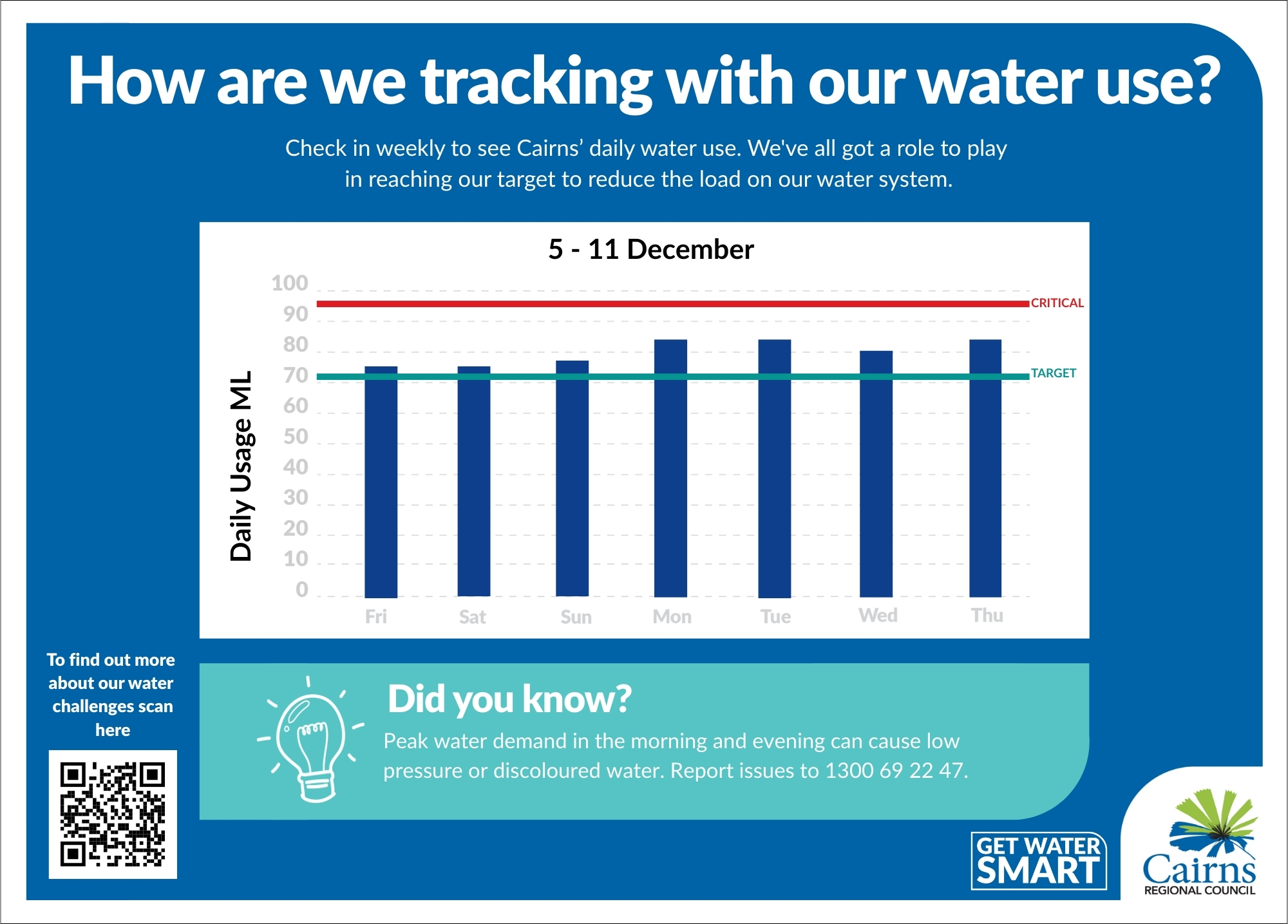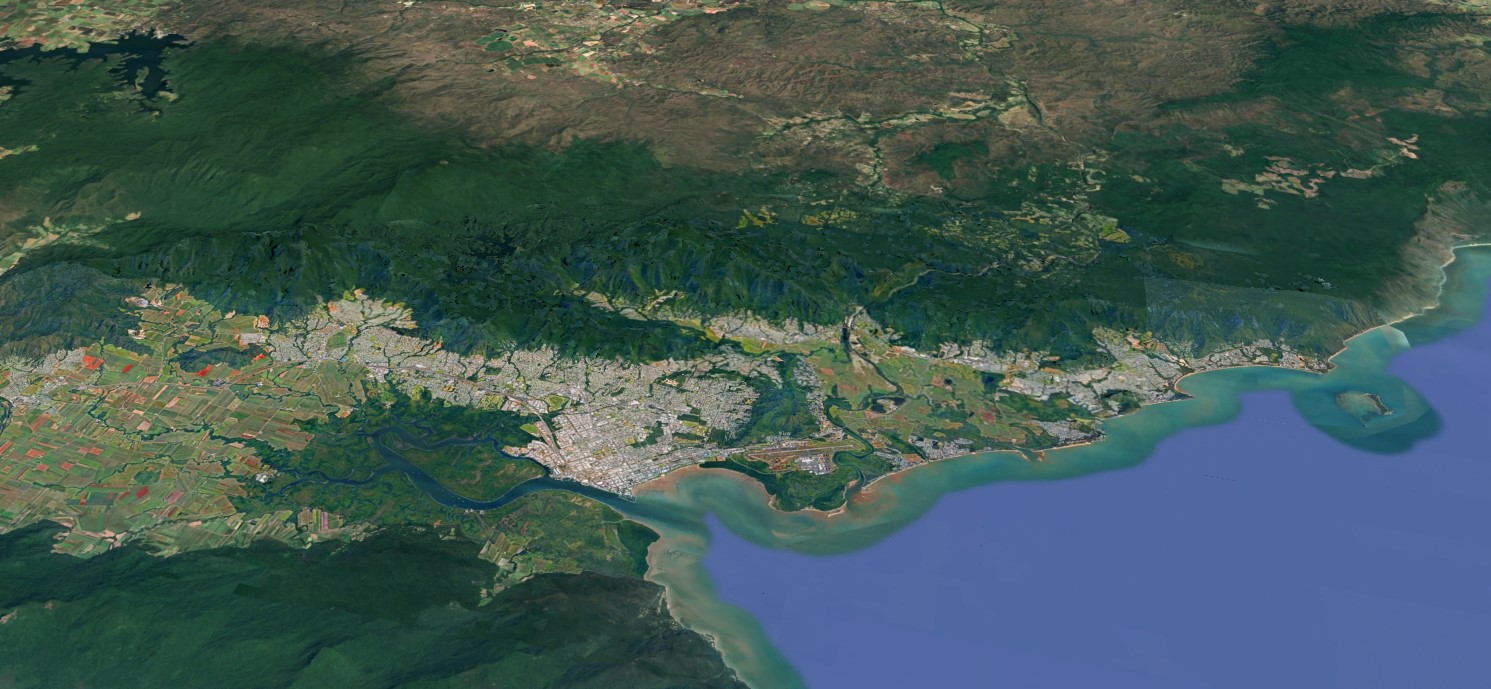About our city's water supply
While Council is progressing the long-term security of our community’s water supply with the Cairns Water Security Stage 1 project, we are also managing a range of immediate challenges with our reservoir network.
Most of Cairns’ drinking water comes from Copperlode Falls Dam, which stores untreated water, and Behana Creek. This water is processed at treatment plants such as Freshwater Creek and Behana Creek and then pumped into a network of 72 reservoirs across the city.
These reservoirs are of varying size and capacity. The network of reservoirs store treated water and help maintain consistent pressure across the city.
Currently, two of these reservoirs (Bayview and Brinsmead) are offline while a third (at James Cook University) is operating at reduced capacity.
This page will feature the latest information and updates as we work to manage the current challenges.

Cairns water network: issues map

Water Supply FAQs
Cairns has a network of 72 reservoirs of varying size and capacity that store treated water and help maintain consistent pressure across the city.
Most of Cairns’ drinking water comes from Copperlode Falls Dam, which stores untreated water and Behana Creek. This water is processed at treatment plants such as Freshwater Creek and Behana Creek and then pumped into a network of 72 reservoirs.
Reservoirs are essential for storing treated water and regulating pressure, so homes and businesses have reliable supply.
Treatment plants make sure the water from Copperlode Dam is safe to drink. During heavy rainfall, however, the Freshwater Creek Treatment Plant sometimes has to shut down due to treatment constraints with dirty water.
Why do treatment plants shut down in heavy rain?
Heavy rain washes sediment and organic material into creeks, making the water cloudy. This is called turbidity (cloudiness caused by fine particles). When turbidity rises above safe levels, the Freshwater Creek Treatment Plant automatically shuts down to protect water quality and customer health. Once conditions improve, staff must manually restart the plant.
How does this affect supply now?
Normally reservoirs provide backup storage during shutdowns. With less storage available, shutdowns have a bigger impact, reducing supply resilience during and after heavy rain.
Two reservoirs (Brinsmead and Bayview) are offline, and a third (University) has reduced capacity. This reduces treated water storage and makes the network more vulnerable to weather events and impacts pressure fluctuations to customers.
Brinsmead Reservoir
This reservoir was taken offline in June 2024 for re-lining to attempt to extend its useful life pending CSWW1 being completed. The relining works were not successful, and the structural condition of its roof has since deteriorated to an extent that access for further rectification work has been restricted.
Council has engaged specialist engineering assistance to implement emergency repairs to return the reservoir to service prior to further works after the wet season. Subject to successfully undertaking these works, Council is currently anticipating the reservoir to be bought back online in mid-December.
Bayview Reservoir
The reservoir was also taken offline in May 2024 for re-lining to attempt to extend its useful life pending CSWW1 being completed. The relining works were not successful, and the structural condition of its roof has since deteriorated to an extent that access for further rectification work has been restricted.
Council is utilising a pump station in close proximity to the reservoir to provide continuity of supply and pressure while this reservoir is offline. It is proposed to remove the roof in the 2026 dry season prior to bringing it back into service. It will remain offline during the 2025-26 wet season.
University Reservoir
Grout injection works were undertaken in the early stages of 2023 to stabilise the foundations. Routine regular monitoring indicated that this work was successful, however further movement was experienced in July 2025 resulting in the reservoir leaking, forcing Council to reduce its storage to 60% of capacity to reduce risk of further movement.
Council has engaged specialist engineering assistance to undertake emergency works to minimise risk of further deterioration. Further geotechnical investigations are being undertaken with the intent of implementing longer-term stabilisation in the 2026 dry season.
Council is simultaneously fast-tracking investigations and design of a replacement reservoir above the existing University reservoir.
With reservoirs offline, water flows directly from the treatment plant into mains, causing pressure fluctuations. This puts extra stress on pipes, making breaks more likely, particularly during peak demand.
Council is taking both short-term and long-term actions to manage current challenges while also delivering projects that will secure Cairns’ water supply for decades to come.
Hasn't Council known about these issues for some time?
A November 2023 report identified risks and recommended re-lining works. These were attempted but were unsuccessful due to structural deterioration. Since then, emergency works, specialist engineering, and planning for long-term solutions have accelerated.
What is Council doing now?
Council is:
- Carrying out emergency repairs at Brinsmead, Bayview and University reservoirs
- Fast-tracking design of a new University Reservoir
- Undertaking engineering investigations for stabilisation at University Reservoir
- Running a community awareness campaign to encourage water conservation
How is Council securing Cairns' water future?
The Cairns Water Security Stage 1 (CWSS1) project is one of the most significant infrastructure projects ever undertaken by Cairns Regional Council.
Driven by the need to meet future demand from population growth, the CWSS1 will secure a safe, reliable, and sustainable water supply for the growing region representing a bold step forward in regional water security.
The project involves building:
- a water intake at the Mulgrave River, near the Desmond Trannore Bridge, Gordonvale
- a water treatment plant and water reservoirs (with storage capacities of 5ML and 8ML), on Council land located at the end of Jones Road, Gordonvale
- a new network of pipeline of approximately 30 kilometres of a mix of steel concrete-lined pipe, PVC, and polyethylene pipe to take raw water to the treatment plant and treated water from the plant to residents.
- Flood protection works at Behana Creek intake, to improve the quality and resilience of that water supply. The existing treatment plant at Behana will be made redundant by the new water treatment plant being built at Gordonvale.
Once operational, the facility will supply up to 60 megalitres of treated water per day significantly boosting the region’s water supply capacity. Cairns Water Security – Stage 1 project is not just about pipes it’s about future-proofing a thriving, sustainable Cairns for generations to come.
Water restrictions are an important tool to manage demand and protect the network. Highlighted by recent rainfall, operational challenges mean restrictions may be introduced sooner than usual.
Why might restrictions be introduced even if it's been raining?
The current issues aren’t about how much rain falls in Cairns or how much water is stored in Copperlode Dam. It’s about how much treated water can be stored during an event and delivered safely to residents. With less treated water storage in reservoirs, restrictions may be required for operational reasons, even during wet conditions.
Copperlode Falls Dam has lots of water. Why would restrictions still be needed?
The dam holds raw (untreated) water. Before it reaches homes, it must pass through treatment plants and reservoirs. The challenge is not water availability but the ability to treat and capacity of the treated water network to deliver it.
What restrictions are already in place permanently?
Cairns has permanent water restrictions in place to encourage responsible use:
- Odd-numbered houses: Sprinklers can be used Tuesday, Thursday and Saturday, between 5–9am and 5–9pm.
- Even-numbered houses: Sprinklers can be used Wednesday, Friday and Sunday, between 5–9am and 5–9pm.
- No sprinkler use on Mondays.
- Hand-held hoses with a trigger nozzle, watering cans and buckets can be used at any time.
These measures are always in effect, regardless of dam levels.
Everyone in Cairns can play a part in protecting our water supply. Small changes at home add up to a big difference across the city.
What practical measures can residents do to help?
Follow the permanent restrictions already in place:
- Odd-numbered houses: Sprinklers can be used Tuesday, Thursday and Saturday, between 5–9am and 5–9pm.
- Even-numbered houses: Sprinklers can be used Wednesday, Friday and Sunday, between 5–9am and 5–9pm.
- No sprinkler use on Mondays.
- Hand-held hoses with a trigger nozzle, watering cans and buckets can be used at any time.
These measures are always in effect, regardless of dam levels.
Additionally, you can:
- Take shorter showers.
- Fix leaking taps or toilets quickly.
- Water gardens in the allowed times, or switch to watering cans and buckets.
- Delay high water-use activities (like washing cars or topping up pools) during peak demand times.
- Report leaks or main breaks promptly so they can be fixed quickly.
- For emergencies / urgent / hazardous situations (e.g. burst water or sewer main) phone 1300 69 22 47 all hours.
- For non-urgent matters:
General contact page for Council: Contact us | Cairns Regional Council
Check out our water supply and use page featuring conservation measures, information on smart water meters and more by clicking here:
Council's irrigation program follows the Cairns Water Demand Management Strategy and the Permanent Water Restrictions that have been in place since 2007. We apply the same time-of-day and frequency rules as residents, adjusting irrigation windows in line with restriction levels. Irrigation schedules shift as required to respond to weather conditions, asset protection priorities and seasonal demand. Council aims to lead by example and demonstrate responsible water use across the city.
Council occasionally conducts daytime system testing and maintenance to ensure efficient performance and prevent leaks that could waste significant volumes of water. This testing is permitted under the Water Restriction Policy. Irrigation timing may also be altered in high-priority or heritage areas to protect rare plant species and high-value public assets, as recognised in the permanent water restriction guidelines. These adjustments help safeguard our parks and gardens, so they stay ready for community use.
Council irrigation systems are programmed to stop during rainfall. If irrigation runs during rain, it is likely due to a malfunction and will be corrected promptly. Watering schedules are adjusted as weather patterns shift, consistent with the city’s Water Demand Management Strategy.
Council has already paused around 70 percent of its irrigation systems across local neighbourhood parks, gardens, verges and Council-managed nature strips. This proactive water-saving measure helps conserve significant volumes of water. The total amount saved will vary depending on climate conditions and irrigation demand.
Yes. Council uses non-potable water where possible to reduce demand on our treated drinking supply. This includes Class A recycled water, which is used at locations such as the Botanic Gardens and local golf courses. Recycled water pipes are coloured purple so they are easy to identify.





